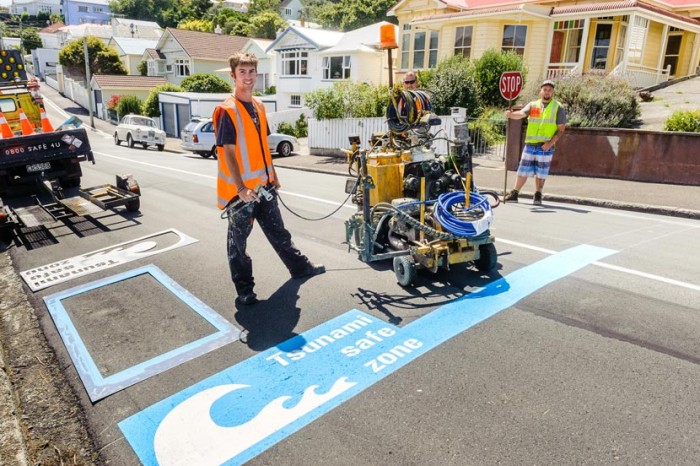
Search your address to find out if you live, work or play in a tsunami zone:
Get Prepared for a tsunami
Before
1. Know and practise your routes to safety
- Where do you need to go? Look at the map and identify places out of the tsunami zones. Tsunami activity can last for up to 24 hours, so think about where you could stay or take shelter if needed.
- What are your routes? Some routes might be faster, while others might be safer because they have fewer dangers (e.g., bridges, bottlenecks, falling debris). Consider these factors when planning your evacuation routes.
- How long does it take? Time yourself and see how long it takes you to get to safety.
What do you need to take? Keep essential supplies near the door. Have an emergency grab bag, as well as comfortable shoes and warm/waterproof clothes ready. This will help save time if you need to leave quickly. - Who else needs to know? Get your household, workplace and/or neighbours involved. Make sure everyone knows the routes and meeting point in case you can't communicate.
2. Learn about official warnings
If you receive an emergency alert, follow the advice given and make sure you are safe. Then make sure your friends and family are safe by sharing the information on social media or by text if it does not delay you. In addition to emergency alerts, information will be provided on our website, and our Facebook and Twitter pages. Media outlets (radio, TV and websites) will also provide information. Find out more information on Emergency Mobile Alerts.
During
How to stay safe in a tsunami:
1. Leave quickly - if you feel a long OR strong earthquake, the first tsunami wave may arrive in as little as ten minutes. There is no time for an official warning; you must evacuate out of all tsunami zones as soon as the shaking stops. Every step towards a tsunami safe zone counts. Stay out of the tsunami evacuation zones until officials say you can go back in.
2. Evacuate tsunami zones by foot or bicycle, don't drive - roads may be blocked by debris or a traffic jam. For those who can't walk or cycle, trying to drive out is their only option, and you could be preventing them from evacuating safely. If you need help evacuating or know someone that does, have a conversation with your neighbours about how everyone can get out safely.
3. Evacuating to a higher floor - we recommend evacuating out of all tsunami zones rather than staying in your building. However, some people who are in a high-rise building may decide it is safer to stay there. If you do stay, you need to be on the fifth floor or higher. This is called 'vertical evacuation'. There are several factors to consider, and this is something you and your household or workplace will need to discuss and decide. Read more about vertical evacuation here
4. If you are told to evacuate, follow the evacuation advice. Move immediately.
Don’t go down to the shore
- The first wave to arrive may not be the largest
- Waves may be separated by an hour or more
- Waves may keep coming for many hours
After
- Stay out of the tsunami zone until you are told by officials it is safe to return home.
- Stay away from coastal areas, tidal estuaries, rivers and streams for at least 24 hours after any tsunami or tsunami warning. Even small waves can create dangerous currents.
- Continue listening to the radio and following Emergency Management advice on facebook @WREMOnzand Twitter @WREMOinfo.
- Help others if you can, and it is safe to do so.
If your property is damaged
- Do not do anything to put your safety at risk.
- Contact your insurance company as soon as possible.
- If you rent your property, contact your landlord and your contents insurance company.
- Take photos of any damage. It will help speed up assessments of your claims. https://www.eqc.govt.nz/taking-photos-to-support-your-claim
Tsunami Blue Lines

Some areas across the Wellington region have blue lines painted across roads and footpaths to show the safe zone if there is a long or strong earthquake. These lines show the maximum possible run-up heights and are based on modelling by GNS Science and Greater Wellington Regional Council. If you live, work or visit the coast, know where the blue lines are and how fast you can get there by foot.
